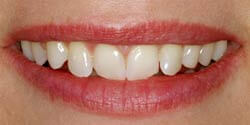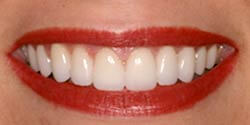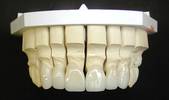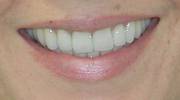
Porcelain Veneers
Porcelain Veneers can correct a lot of things …
Porcelain veneers are the most conservative esthetic restorations available in dentistry today. A thin layer of the front of the tooth is removed to allow a veneer of porcelain to be bonded to the tooth without making it any thicker. Similar, in a way, to a false fingernail, the veneer covers dark or yellow teeth, fills unsightly gaps, lengthens short or stubby teeth, straightens crooked teeth, and in general creates a more attractive smile. Unlike a false fingernail, veneers are more permanent. The veneers are attached to the teeth using the most advanced methods of bonding principles.


A Cost Comparison and Tips on Your Winning Smile
Are you afraid to smile or embarrassed about your teeth? Or maybe you just want a better-looking smile. Recapturing the beauty of your smile is easier than you think.
Dental veneers are a rapid, aesthetic, and a safe way to correct unattractive front teeth. Veneers are the primary smile enhancement used by dentists in makeovers and can dramatically improve your appearance!
The increased popularity of dental veneers is due to the advancement in bonding techniques and materials over the past two decades. Now, with routine dental care and the procedure performed by a qualified aesthetic dentist, your veneers can last 15 years or more. A fast treatment can be completed in only two office visits.
What are Dental Veneers?
Dental veneers are wafer thin, semi-translucent facings that bond securely to the fronts of your teeth. Dental veneers are durable, stain-resistant, and natural looking. Usually made of porcelain, they are custom designed by your dentist specifically for your teeth, and then fabricated at a specialty lab, and finally bonded permanently to your teeth.
To create cosmetically a uniform, white, beautiful smile


Why choose dental veneers?
- Straighten crooked teeth
- Reposition misaligned teeth
- Reshape teeth that are a poor size or shape
- Whiten severely discolored or stained teeth
- Close unwanted or uneven spaces
- Restore worn or chipped teeth
- Revitalize old crown and bridgework
Who is a candidate for Dental Veneers?
Anyone with healthy teeth and a normal bite can consider dental veneers. If you have any cavities, periodontal disease, or an improper bite, these issues must be first addressed. An improper bite is typically the single reason that patients have veneers fracture or come off. An improper bite is a bite that does not have neuromuscular harmony due to the position of the jaw and teeth. The signs are worn or chipped teeth, grinding or clenching at night, broken dental work, facial pain, and possibly head and neck aches. The dentist must address these issues before restoring the smile with veneers or breakage will occur once the veneers are delivered.
What are the advantages of veneers?
- Create a uniform, white, beautiful smile.
- They provide a natural tooth appearance.
- Gum tissue tolerates porcelain well.
- The color of the veneers can be selected by the patient resulting in a smile as white as the patient desires.
- Porcelain veneers are stain resistant.
- Veneers are very durable.
- They are very conservative with tooth reduction (0.3 to 1.2 mm).
- Porcelain veneers can last for up to a lifetime.
- Veneers are a quick result with few appointments in comparison with alternative treatments of braces or Invisalign.
What are the disadvantages, complication and risks of veneers?
- The process is not reversible.
- Veneers are more costly than composite resin bonding.
- Veneers are not usually repairable should they chip or crack.
- Because enamel has been removed, your tooth may become more sensitive to hot and cold foods and beverages.
- Porcelain does not whiten with bleaching. Plan on whitening teeth not receiving veneers before having veneers placed so that all teeth match after veneer placement.
- In rare cases veneers can fall off. To prevent veneer loss patients should avoid biting on hard foods or objects such as ice, nails or bones.
What are the alternatives to veneers?
Braces
Since healthy, aligned teeth are the foundation of a beautiful smile, braces may be the best solution if a patient has severe crowding, a cross-bite, or an over-bite. This is because teeth that do not fit together correctly can cause tooth decay, bone loss, bite problems, and other issues if left untreated. Unlike veneers, which conceal crooked teeth, braces straighten teeth and prevent problems caused by misalignment.
Invisalign
For patients with minor misalignment, Invisalign can be an excellent option for obtaining a balanced, healthy smile. The Invisalign system provides the benefits of braces – correcting misalignment instead of camouflaging it like veneers – without conspicuous metal or ceramic brackets. Instead, the Invisalign system uses a series of clear plastic trays that gradually reposition the teeth. The trays are comfortable, removable, and virtually invisible, making them popular among orthodontic patients of all ages.
Dental Bonding
For minor chips, cracks, and discolorations, dental bonding may be all that is needed to enhance your smile. Unlike placing porcelain veneers, dental bonding does not require removal of the natural tooth structure. Instead, the bonding composite resin material is applied directly to the surface of the tooth. Dental bonding is less expensive than veneers, but discolor and need to be renewed more frequently. Dental bonding can be done for the best results following braces, Invisalign or whitening.
Tooth Whitening
Tooth whitening is a very inexpensive, safe and effective way to improve a smile. It restores the teeth back to the original youthful color, and treatments can be limited to the dental office, administered by a dentist for at home treatment, or found over the counter. The term tooth bleaching is used when the teeth can be whitened beyond their natural color. Although many dentists claim to be able to achieve this, only a select group knowing the correct technique and materials can achieve this result. In many cases, tooth whitening in conjunction with braces, Invisalign and bonding gives the best result.
How much do veneers cost?
The costs for veneers can vary greatly between dental offices in one particular region, different regions, or where the practice is located. The patient must keep in mind that a veneer is not just a veneer. Why is a veneer not just a veneer? There are many factors that influence price such as: the materials or type of porcelain used (empress3, feldspathic, Cerinate Lumineers, Procera); will the roots be affected; how much tooth structure is available; where the dentist was trained; how many aesthetic dentistry continuing education courses they are taking; how often they are changing smiles with veneers; where they are located; what types of bonding materials they use; what qualification there dental technician has; and do they offer a warranty for the dental work.
Do your research and find out the answers to some of these questions to find out if the price is a fair one. One good way is to view the doctor’s cases. If they are experienced they should have many full mouth cases to show you. If not, their technical skills may be lacking the experience.
Average veneer prices for Germany:
Price for 1 veneer: 450 – 1800 Euros
Price for 8-10 veneers (smile makeover): 3600 – 18000 Euro
A full set of veneers: Priceless
Dentist Charles A. Smith’s Smile Design
A smile makeover is the process of improving the appearance of the smile through one or more aesthetic dentistry procedures such as dental veneers, composite bonding, dental implants, orthodontics and teeth whitening. Essentially, a smile makeover is something that you choose to have performed, while a full mouth reconstruction is something you need to have performed.
A smile makeover takes into consideration your facial appearance, skin tone, hair color, teeth (color, width, length, shape and tooth display), gum tissue and lips to develop your ideal smile.
Dentist Charles Smith starts first with determining the patient’s wants. Success is determined by the patient. The patient must decide the color and shape of the teeth. To assist with this, Charles Smith DDS uses a “Smile Guide” with pictures of different shaped teeth for the patient to view, cosmetic imaging of a photograph of the patients teeth to a desired result, or a composite resin mock-up in the mouth. The composite mock-up is a quick and easy non-permanent method to allow the patient to see and feel how their teeth might look.
Charles Smith’s rules of smile design:
- Proper size proportion of the central incisors. The proper width to length ratio is 75%-80%.
- Golden proportion. The golden proportion is a parameter found in nature that defines harmony and therefore beauty. Studies and experiments that the golden proportion creates an aesthetic appeal, independent from ethnic or civilization factors. The golden proportion is 1.00 : 1.618 and is seen in nature, the building of the pyramids, and facial and dental elements.
- Midline and arch alignment
- Shape of the smile in comparison with the tips of the teeth
- Proper contact point position
- Proper arch form
- Gingival symmetry and contour. When the gingiva is not ideal it is altered surgically with a soft tissue diode laser at the time of treatment. This procedure is quick, painless, and heals within a day.


Charles A. Smith’s Dental Veneer Process
Free Complimentary Consultation
Charles A. Smith will examine your mouth and discuss treatment options with advantages and disadvantages of each treatment. If the patient decides to accept veneer treatment then models and photographs will be taken and charged. The color and shape will also be determined.
Veneer Preparation Appointment
The teeth have 0.3mm to 1.2mm of tooth structure removed to allow room for the veneer. The gingival contours and heights will be adjusted to optimize aesthetics. The teeth that are darker than the others will be whitened after being prepared to ensure uniform color to the final restorations. Smith DDS will fit temporary veneers to the shape and size that was determined together at the first visit. The temporaries will look and feel just like the final veneers. If aesthetically the teeth do not look ideal or to the desired result, then improvements are made in the temporaries before the final veneers are made so that the ideal shape, length and color are achieved in the final veneers.


Veneer Application Appointment
The final veneers are tried on this visit. If you and Smith DDS are completely satisfied the veneers will be bonded in place. Charles A. Smith will not finalize your veneers until you both are satisfied with the results.Necessary alterations will be made in close cooperation with the (dental) lab. Although your teeth may be a little sensitive to food or beverages for a couple days, generally there is no recovery process.
